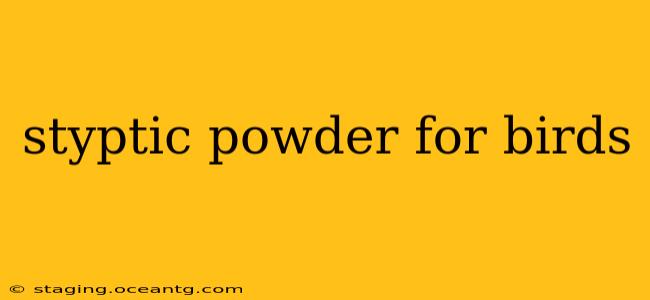Styptic powder is often used to stop bleeding in humans, but its use on birds requires caution and careful consideration. While it can be effective in staunching minor bleeding, improper application can cause harm. This article explores the safe and effective use of styptic powder for birds, examines alternatives, and highlights when veterinary intervention is crucial.
What is Styptic Powder?
Styptic powder is a substance typically containing alum, which helps clot blood by constricting blood vessels. It's readily available in human pharmacies, often used to control bleeding from minor cuts. However, its application to birds, particularly small ones, requires a delicate touch and understanding of potential risks.
Can I Use Styptic Powder on My Bird?
The short answer is: use with extreme caution, and only for minor bleeding. The delicate nature of a bird's skin and its susceptibility to infection means that any application should be minimal. Using too much styptic powder or applying it incorrectly can irritate the skin, potentially leading to infection or further complications.
How to Use Styptic Powder on Birds (If Necessary)
If you must use styptic powder, proceed with extreme care:
- Assess the Injury: Only use styptic powder on minor, superficial wounds. Deep cuts, significant bleeding, or wounds showing signs of infection require immediate veterinary attention.
- Clean the Wound: Gently clean the affected area with clean, warm water. Avoid harsh chemicals or antiseptic solutions, as these can irritate the bird's sensitive skin.
- Apply Sparingly: Use a tiny amount of styptic powder, applying it directly to the bleeding area. Avoid getting it in the bird's eyes or allowing it to be ingested.
- Monitor Closely: Observe your bird for any adverse reactions, such as swelling, redness, or increased distress.
- Seek Veterinary Care: If the bleeding doesn't stop, the wound shows signs of infection, or your bird exhibits any concerning symptoms, seek immediate veterinary care.
What are the Alternatives to Styptic Powder for Birds?
Several safer alternatives exist for controlling minor bleeding in birds:
- Gentle Pressure: Applying gentle pressure to the wound with a clean cloth or tissue can often be enough to stop minor bleeding.
- Cornstarch: Cornstarch can help absorb blood and promote clotting.
- Flour: Similar to cornstarch, flour can be used to absorb blood and assist in clotting.
When Should I Take My Bird to the Vet?
It's crucial to seek immediate veterinary care if:
- The bleeding is profuse or doesn't stop after applying gentle pressure.
- The wound is deep or involves a bone or joint.
- The wound shows signs of infection (swelling, redness, pus).
- Your bird is exhibiting signs of distress, lethargy, or changes in behavior.
Remember, a veterinarian is best equipped to assess the injury, provide appropriate treatment, and monitor your bird's recovery.
Frequently Asked Questions (FAQ)
Is styptic pencil better than powder for birds?
Styptic pencils, similar to powder, should be used with extreme caution. The same principles of minimal application and careful monitoring apply. Due to the potential for irritation and difficulty in precise application on a small bird, other methods are generally preferred.
What if my bird pecks at the wound after applying styptic powder?
This is a common concern. If your bird is actively pecking at the wound, it may indicate discomfort or the presence of an irritant. In such cases, seeking veterinary attention is crucial. They can assess the wound and suggest appropriate measures to prevent further damage or infection.
Can I use human antiseptic on my bird's wound?
Many human antiseptics are too harsh for a bird's delicate skin. It's best to avoid using them and opt for clean water or consult a veterinarian for advice on appropriate cleaning solutions for avian wounds.
Remember, preventing injuries is the best approach. Provide a safe and secure environment for your bird to minimize the risk of wounds requiring any type of treatment. Always err on the side of caution and consult an avian veterinarian for any concerns regarding your bird's health.
